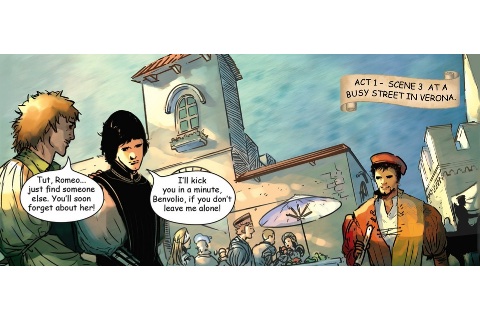Graphic novels are like comic books but differ in that they are longer and more artful. I believe that using graphic novels to teach Shakespeare literature would engage students more than traditional Shakespeare novels because graphic novels include many illustrations that would capture students’ attention. Schwartz (2006) believes that using graphic novels in classrooms more often would assist students in “analyzing literary conventions, character development, dialogue, satire, and language structure” (58); this would be due to the appealing illustrations and simplified language that graphic novels offer.
Students may also create their own graphic novel to demonstrate what they consider the most important scenes from Romeo and Juliet. By doing this, students would learn literary elements such as narrative style and character development in a way that makes the most sense to them. They may also use a wife variety of shades, color, panel layout, and lettering style to showcase different scenes in the book. This requires much more critical thinking than simply reading and interpreting a traditional Shakespeare play.
However, teachers must become familiar with graphic novels before they are used in classrooms. Many graphic novels are filled with profanity and sexual and violent content. Teachers must educate themselves on particular graphic novels before they are given out to students. Because graphic novels are a fairly new phenomenon and have yet to be introduced to classrooms commonly, both teachers and students have the opportunity to work together to make meanings and explore this modality in greater depth.
An example of a scene from a graphic novel:
